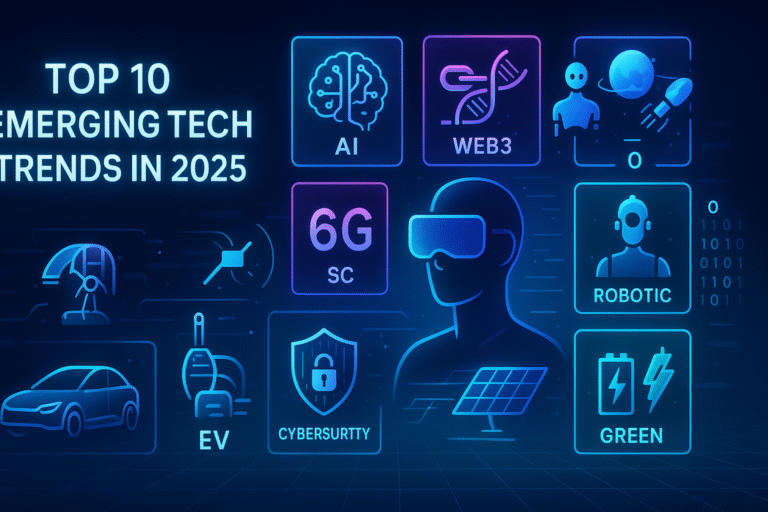The Rise of Green Technologies in 2025: What You Need to Know

The Rise of Green Technologies in 2025: What You Need to Know
In 2025, green technologies are more than just a trend—they are an essential part of the fight against climate change. As environmental concerns grow, businesses and consumers alike are turning to sustainable solutions to reduce their impact. Green technologies are paving the way toward a cleaner, more efficient future, transforming industries and everyday life. This blog delves into the most prominent green technologies of 2025 and their impact on our world.
Table of Contents
- Introduction: The Growing Importance of Green Technologies in 2025
- Key Green Technologies Revolutionizing Industries
- The Role of Renewable Energy in the Green Tech Movement
- AI and Automation in Green Tech: A Perfect Match
- Green Technologies in the Automotive Industry: A Cleaner Future
- The Role of Green Technologies in Reducing Carbon Emissions
- How Green Tech is Changing Consumer Habits
- Investment Opportunities in Green Tech for 2025
- Challenges Facing the Green Tech Industry
- Conclusion: A Sustainable Future Powered by Green Technologies
Key Green Technologies Revolutionizing Industries
Green technologies encompass various innovations designed to reduce environmental impact. Some key technologies in 2025 include:
- Solar Power: More efficient solar panels are making renewable energy more accessible and affordable. In 2025, large-scale solar farms are providing power to millions of homes, while solar panels are becoming commonplace on residential roofs.
- Wind Energy: Offshore wind farms are becoming major contributors to renewable energy, with more powerful and efficient turbines generating electricity.
- Electric Vehicles (EVs): The automotive industry is undergoing a massive shift toward electric vehicles. With better battery technology and reduced prices, EVs are becoming a mainstream choice for consumers.
- Sustainable Agriculture: Innovations such as vertical farming and precision irrigation are optimizing food production while minimizing waste and environmental impact.
The Role of Renewable Energy in the Green Tech Movement
Renewable energy is the backbone of the green tech revolution. By 2025, more regions are integrating solar, wind, and hydropower into their energy grids. These sources are reducing our reliance on fossil fuels and mitigating the effects of climate change. Large-scale solar farms and offshore wind projects are making a significant impact in reducing carbon emissions globally.
AI and Automation in Green Tech: A Perfect Match
AI and automation are key to unlocking the full potential of green technologies. By 2025, AI is helping optimize energy consumption, reduce waste, and increase efficiency in manufacturing. Some of the most exciting applications include:
- Smart Grids: AI-powered smart grids are optimizing electricity distribution, reducing energy waste and enabling real-time monitoring of energy usage.
- Automated Waste Management: AI is revolutionizing waste management by enabling smarter recycling and energy recovery systems.
- Sustainable Architecture: AI tools are being used in green building design to create energy-efficient structures with minimal environmental impact.
Green Technologies in the Automotive Industry: A Cleaner Future
The automotive industry is one of the biggest beneficiaries of green technologies. Electric vehicles (EVs) are quickly gaining traction due to advancements in battery technology. In 2025, EVs have longer ranges, shorter charging times, and are more affordable than ever. Governments are supporting this shift with incentives, and major automakers are transitioning to electric fleets.
Additionally, hydrogen fuel cells and biofuels are emerging as viable alternatives to gasoline and diesel engines, contributing to a cleaner transportation sector.
The Role of Green Technologies in Reducing Carbon Emissions
Reducing carbon emissions is a key goal of green technologies. By transitioning to renewable energy sources and optimizing processes, industries can significantly lower their carbon footprints. Carbon capture and storage (CCS) technologies are also helping industries reduce their emissions, especially in hard-to-decarbonize sectors like manufacturing.
In 2025, green tech is helping countries meet their carbon reduction targets, with many regions shifting toward carbon-neutral policies and adopting green technologies at a large scale.
How Green Tech is Changing Consumer Habits
Consumers are becoming more eco-conscious and are increasingly choosing products and services that align with their values. In 2025, the demand for sustainable products—from electric vehicles and solar-powered gadgets to eco-friendly fashion and green home appliances—is on the rise.
Companies are responding by adopting green technologies in their production and packaging processes. This shift in consumer preferences is pushing businesses to innovate and reduce their environmental impact.
Investment Opportunities in Green Tech for 2025
The green tech industry is one of the most promising sectors for investment in 2025. As governments, businesses, and individuals embrace sustainability, green technologies are set to see significant growth. Key investment opportunities include:
- Renewable Energy: Solar and wind energy projects are growing rapidly, and energy storage solutions are becoming essential for grid stability.
- Electric Vehicles: With increasing demand for EVs, investment in battery production, charging infrastructure, and vehicle manufacturing is a lucrative opportunity.
- Sustainable Agriculture and Green Startups: Companies working on solutions like precision farming, vertical farming, and carbon capture technologies are leading the charge in sustainable innovation.
Challenges Facing the Green Tech Industry
Despite the promise of green technologies, there are several challenges that need to be addressed:
- High Initial Costs: Many green technologies require substantial upfront investments in infrastructure and research, which can slow down adoption.
- Regulatory Hurdles: Governments must establish clearer policies and incentives to foster the growth of green technologies.
- Market Adoption: Many industries and consumers are hesitant to adopt new green technologies due to perceived high costs or a lack of awareness.
Conclusion: A Sustainable Future Powered by Green Technologies
As we move through 2025, green technologies are proving essential in the global effort to combat climate change. From renewable energy to AI-powered solutions and sustainable consumer products, these innovations are driving industries toward a cleaner, more sustainable future. For individuals, businesses, and governments, embracing green technologies is not just an option—it’s a responsibility.
External Link:
To learn more about renewable energy and its role in combating climate change, check out Renewable Energy World – A Global Source of Clean Energy News.
Internal Link :-
5 Bhagavad Gita Inspired Habits Every Entrepreneur Should Practice Daily








One Comment